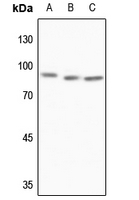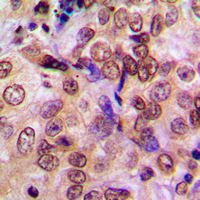Anti-MTA1 Antibody
Rabbit polyclonal antibody to MTA1
- 产品详情
- 实验流程
- 背景知识
Application
| WB, IHC |
|---|---|
| Primary Accession | Q13330 |
| Other Accession | Q8K4B0 |
| Reactivity | Human, Mouse, Rat |
| Host | Rabbit |
| Clonality | Polyclonal |
| Calculated MW | 80786 Da |
| Gene ID | 9112 |
|---|---|
| Other Names | Metastasis-associated protein MTA1 |
| Target/Specificity | KLH-conjugated synthetic peptide encompassing a sequence within the center region of human MTA1. The exact sequence is proprietary. |
| Dilution | WB~~WB (1/500 - 1/1000), IHC (1/100 - 1/200) IHC~~WB (1/500 - 1/1000), IHC (1/100 - 1/200) |
| Format | Liquid in 0.42% Potassium phosphate, 0.87% Sodium chloride, pH 7.3, 30% glycerol, and 0.09% (W/V) sodium azide. |
| Storage | Store at -20 °C.Stable for 12 months from date of receipt |
| Name | MTA1 |
|---|---|
| Function | Transcriptional coregulator which can act as both a transcriptional corepressor and coactivator (PubMed:16617102, PubMed:17671180, PubMed:17922032, PubMed:21965678, PubMed:24413532). Acts as a component of the histone deacetylase NuRD complex which participates in the remodeling of chromatin (PubMed:16428440, PubMed:28977666). In the NuRD complex, regulates transcription of its targets by modifying the acetylation status of the target chromatin and cofactor accessibility to the target DNA (PubMed:17671180). In conjunction with other components of NuRD, acts as a transcriptional corepressor of BRCA1, ESR1, TFF1 and CDKN1A (PubMed:17922032, PubMed:24413532). Acts as a transcriptional coactivator of BCAS3, and SUMO2, independent of the NuRD complex (PubMed:16617102, PubMed:17671180, PubMed:21965678). Stimulates the expression of WNT1 by inhibiting the expression of its transcriptional corepressor SIX3 (By similarity). Regulates p53-dependent and -independent DNA repair processes following genotoxic stress (PubMed:19837670). Regulates the stability and function of p53/TP53 by inhibiting its ubiquitination by COP1 and MDM2 thereby regulating the p53-dependent DNA repair (PubMed:19837670). Plays a role in the regulation of the circadian clock and is essential for the generation and maintenance of circadian rhythms under constant light and for normal entrainment of behavior to light-dark (LD) cycles (By similarity). Positively regulates the CLOCK- BMAL1 heterodimer mediated transcriptional activation of its own transcription and the transcription of CRY1 (By similarity). Regulates deacetylation of BMAL1 by regulating SIRT1 expression, resulting in derepressing CRY1-mediated transcription repression (By similarity). With TFCP2L1, promotes establishment and maintenance of pluripotency in embryonic stem cells (ESCs) and inhibits endoderm differentiation (By similarity). |
| Cellular Location | Nucleus [Isoform Long]: Nucleus. Nucleus envelope. Cytoplasm. Cytoplasm, cytoskeleton. Note=Associated with microtubules (PubMed:24970816). Localization at the nuclear envelope is TPR- dependent (PubMed:24970816). |
| Tissue Location | Widely expressed. High expression in brain, liver, kidney, and cardiac muscle, ovaries, adrenal glands and virgin mammary glands. Higher in tumors than in adjacent normal tissue from the same individual. Up-regulated in a wide variety of cancers including breast, liver, ovarian, and colorectal cancer and its expression levels are closely correlated with tumor aggressiveness and metastasis |
Research Areas
For Research Use Only. Not For Use In Diagnostic Procedures.
Application Protocols
Provided below are standard protocols that you may find useful for product applications.
BACKGROUND
KLH-conjugated synthetic peptide encompassing a sequence within the center region of human MTA1. The exact sequence is proprietary.
终于等到您。ABCEPTA(百远生物)抗体产品。
点击下方“我要评价 ”按钮提交您的反馈信息,您的反馈和评价是我们最宝贵的财富之一,
我们将在1-3个工作日内处理您的反馈信息。
如有疑问,联系:0512-88856768 tech-china@abcepta.com.
¥ 1,500.00
Cat# AP60489























 癌症的基本特征包括细胞增殖、血管生成、迁移、凋亡逃避机制和细胞永生等。找到癌症发生过程中这些通路的关键标记物和对应的抗体用于检测至关重要。
癌症的基本特征包括细胞增殖、血管生成、迁移、凋亡逃避机制和细胞永生等。找到癌症发生过程中这些通路的关键标记物和对应的抗体用于检测至关重要。 为您推荐一个泛素化位点预测神器——泛素化分析工具,可以为您的蛋白的泛素化位点作出预测和评分。
为您推荐一个泛素化位点预测神器——泛素化分析工具,可以为您的蛋白的泛素化位点作出预测和评分。 细胞自噬受体图形绘图工具为你的蛋白的细胞受体结合位点作出预测和评分,识别结合到自噬通路中的蛋白是非常重要的,便于让我们理解自噬在正常生理、病理过程中的作用,如发育、细胞分化、神经退化性疾病、压力条件下、感染和癌症。
细胞自噬受体图形绘图工具为你的蛋白的细胞受体结合位点作出预测和评分,识别结合到自噬通路中的蛋白是非常重要的,便于让我们理解自噬在正常生理、病理过程中的作用,如发育、细胞分化、神经退化性疾病、压力条件下、感染和癌症。







